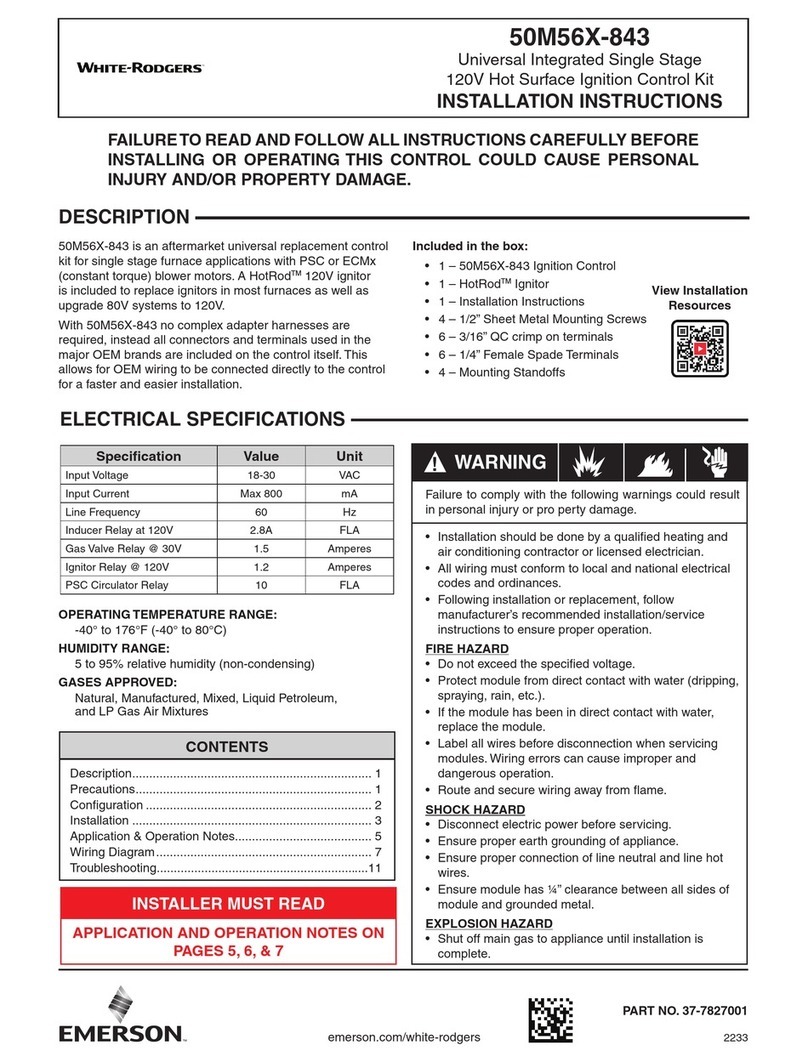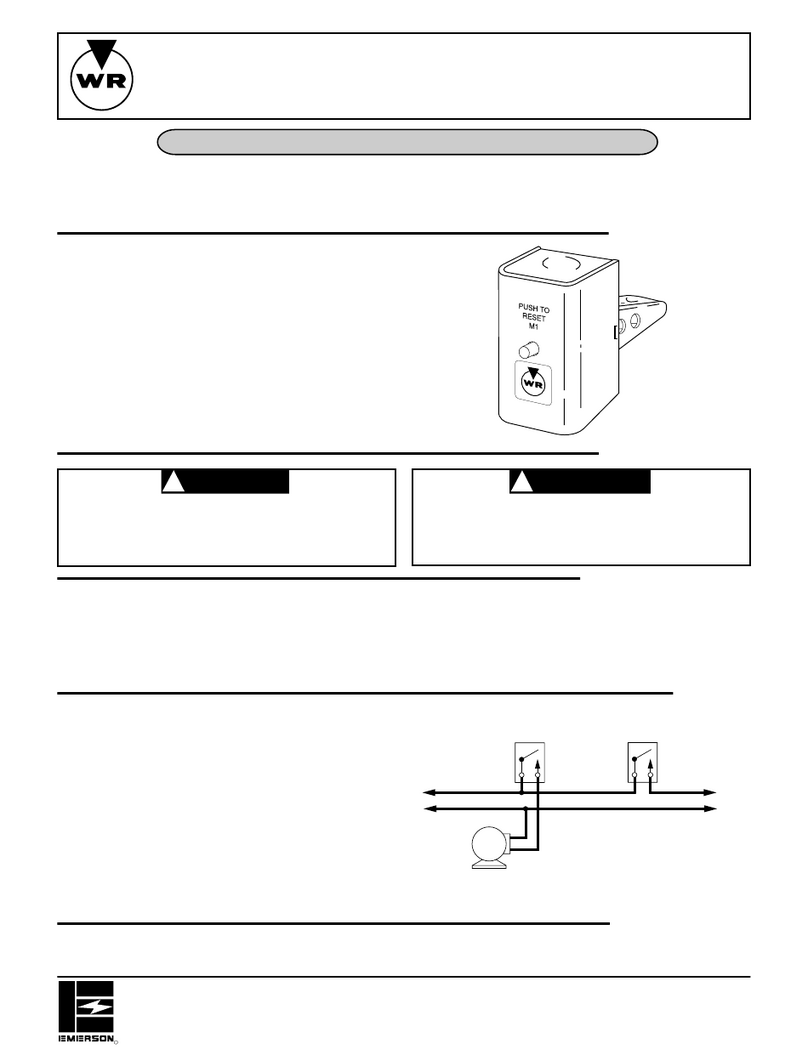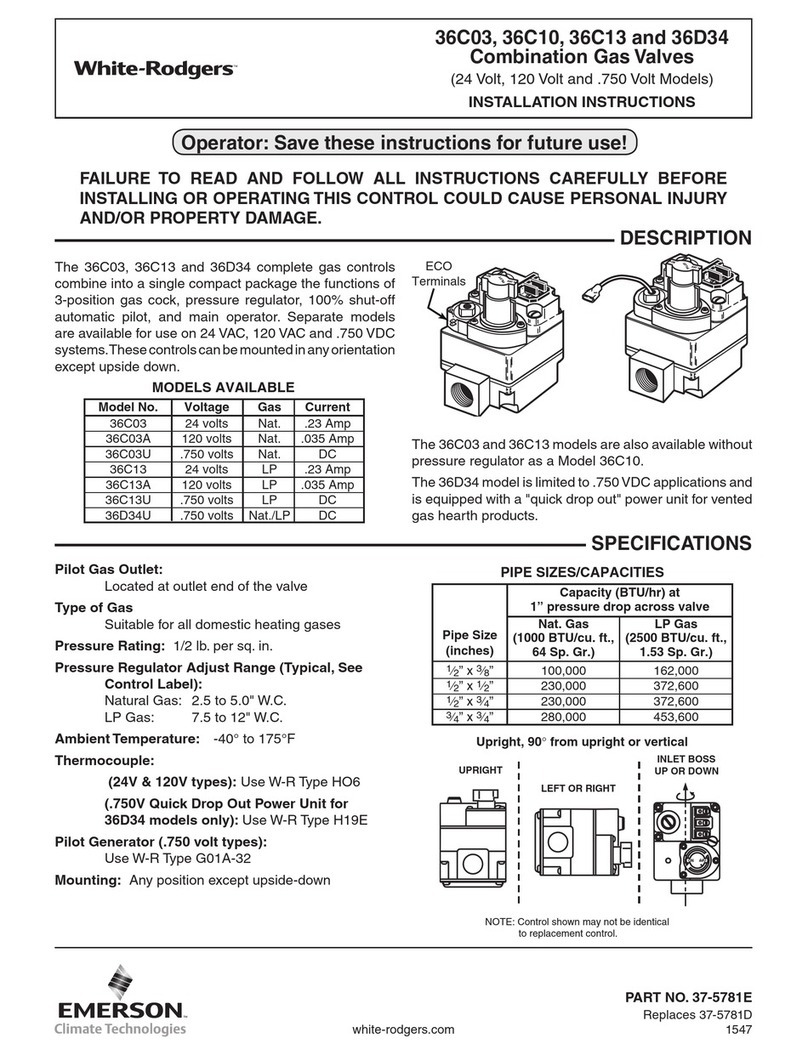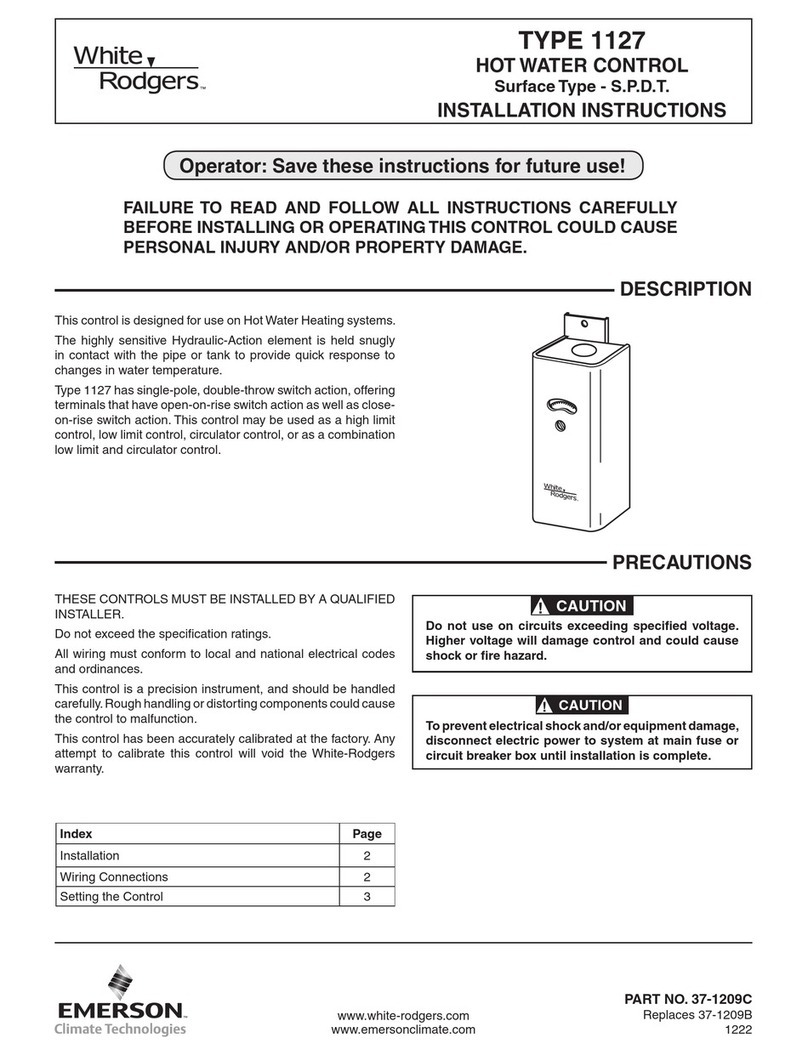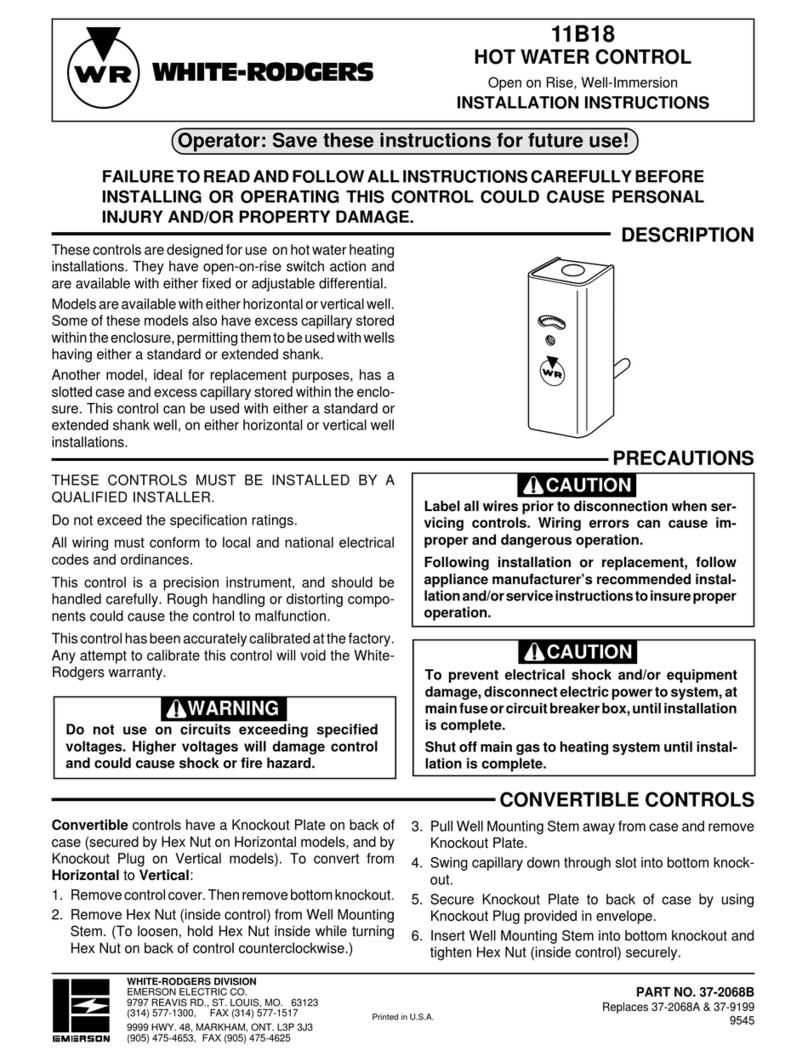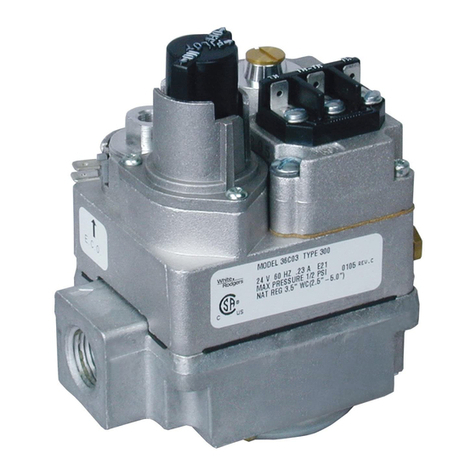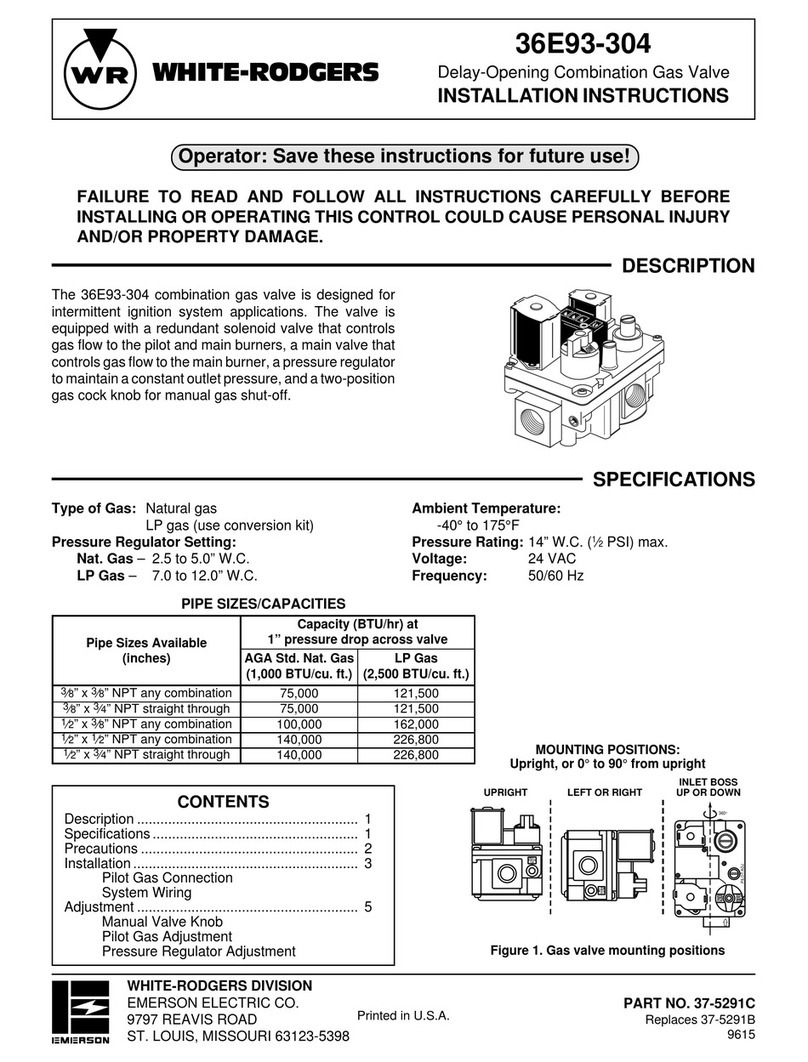
3
HEAT MODE
In a typical system, a call for first stage heat is initiated by
closing the W1 thermostat contacts. The Humidifier output is
energized and the inducer blower is enabled at low speed. The
control waits for the stage 1 pressure switch to close. When
the pressure switch closes the silicon nitride ignitor is powered.
This control has an adaptive algorithm that reduces the ignitor
temperature to slightly greater than the minimum temperature
required to ignite gas in each particular application. The con-
trol measures the line voltage and determines an initial ignitor
temperature setting based on the measurement. After each
successful ignition, the control lowers the ignitor temperature
slightly for the next ignition attempt. The control continues to
lower the ignitor temperature until ignition does not occur, and
the control goes into retry mode. For the second attempt to
ignite gas within the same call for heat, the control increases
the ignitor temperature to the value it was on the previous
successful ignition. After ignition is successful, the control sets
the ignition temperature at this value. The control is constantly
making adjustments to the ignitor modulation routine to com-
pensate for changes in the line voltage. The control will relearn
after power interruptions.
The Silicon Nitride ignitor manufactured by White-Rodgers
must be used.These ignitors are specially designed to operate
with the adaptive ignition routine used by the control to ensure
the most efficient ignitor temperature.
At the end of the ignitor warm-up time, the first stage of the two-
stage manifold gas valve is energized (low fire). Flame must be
detected within 5 seconds. If flame is detected, the 45 second
delay-to-fan-on period begins. After the delay-to-fan-on period
ends, the circulator enable, (pin 15 on the 16-pin connector is
the “E” output to the circulator) and air cleaner are energized.
A call for second stage heat (W1 and W2) after a call for first
stage heat will activate a 30-second 2nd stage delay. Following
the 30-second delay, the inducer motor is driven at high speed.
The control checks the 2nd stage pressure switch. When the
pressure switch closes, the 2nd stage gas valve turns on and
the circulator is enabled at high speed (“E” remains energized
any time the circulator is on).
When the second stage of the thermostat is satisfied, the inducer
motor is reduced to low speed, and the 2nd stage gas valve and
high circulator speed are de-energized.
When the first stage of the thermostat is satisfied, the gas valve
is de-energized and the heat delay-to-fan-off timing begins.The
inducer will postpurge for an additional 5 seconds. When this
time is expired, the inducer and humidifier will de-energize.Upon
completion of the heat delay-to-fan-off period, the circulator and
air cleaner are de-energized.
If flame is not detected during the trial-for-ignition period, the gas
valve is de-energized, the ignitor is turned off, and the control
goes into the “retry” sequence.
The “retry” sequence starts with a 60-second interpurge, en-
abling the inducer at low speed for 60 seconds following an
unsuccessful ignition attempt (flame not detected). After this
wait, the ignition sequence is restarted. If this ignition attempt
is unsuccessful, one more retry will be made before the control
goes into system lockout.
If flame is detected, then lost, the control will repeat the initial ig-
nition sequence for a total of ten “recycles”.After ten unsuccessful
attempts to sustain flame, the control will go into system lockout.
During burner operation, a momentary loss of power of 250
milliseconds or longer will de-energize the main gas valve.When
power is restored, the gas valve will remain de-energized and a
restart of the ignition sequence will begin immediately.
A momentary loss of gas supply, flame blowout, or a shorted or
open condition in the flame probe circuit will be sensed within
2 seconds. The gas valve will de-energize and the control will
restart the ignition sequence.Recycles will begin and the burner
will operate normally if the gas supply returns, or the fault con-
dition is corrected, before the last ignition attempt. Otherwise,
the control will go into system lockout.
If the control has gone into system lockout, it may be possible
to reset the control by a momentary power interruption of five
seconds or longer. Refer to PRECAUTIONARY, SYSTEM
LOCKOUT, AND DIAGNOSTIC FEATURES.
COOL MODE
In a typical system, a call for cool is initiated by closing the
thermostat contacts. This energizes the compressor, circulator
“E” output and air cleaner. After the thermostat is satisfied, the
compressor is de-energized and the optional cool mode delay-
to-fan-off period begins.After the optional delay-to-fan-off period
ends, the circulator “E” output and air cleaner are de-energized.
MANUAL FAN ON MODE
If the thermostat fan switch is moved to the ON position, the
circulator “E” output and air cleaner are energized. When the
fan switch is returned to the AUTO position, the circulator “E”
output and air cleaner are de-energized.
PRECAUTIONARY, SYSTEM LOCK-
OUT, AND DIAGNOSTIC FEATURES
PRECAUTIONARY FEATURES
The following precautionary features are built into the control.
1. If the high temperature limit or flame rollout sensor open
at any time, the gas valve is de-energized.
2. During a call for heat cycle, if flame is sensed at any time
when the gas valve is de-energized, the circulation “E”output
and inducer fan are energized at low speed in conjunction
with system lockout.
3. If the high limit (and/or auxiliary limit) switch(es) open at
any time during a call for heat, the circulator blower and
inducer fan are energized at low speed.
SYSTEM LOCKOUT FEATURES
When system lockout occurs, the gas valve is de-energized, the
circulator “E” output and the inducer blower are energized at low
speed.The diagnostic indicator light will flash to indicate system
status.(System lockout will never override the precautionary
features described above.)
To reset the control after system lockout, do one of the
following:
1. Interrupt the call for heat at the thermostat for at least one
second and less than twenty seconds (if flame is sensed
OPERATION


